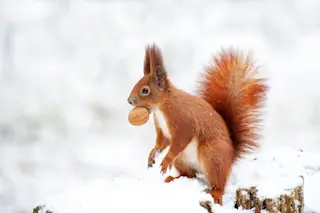As leaves turn brown and frigid winds start sweeping through the Northern hemisphere of the world, animals need to prepare for the winter months to come. This doesn’t look the same for all animals, though, as they’ve evolved several techniques to brave the cold and survive.
(Credit: Steve Oehlenschlager/Shutterstock)
Steve Oehlenschlager/Shutterstock
When the temperatures drop, many animals skip town and head south — chasing entirely warmer climates.
Some animals — like the chamois, elks, and ibexes — might descend a couple of miles from the mountaintop and spend the colder months at lower altitudes, where the weather is slightly warmer.
Migration is especially common in birds, who can fly long routes across the globe pursuing the sunshine. Geese, flying in V-shapes, are the first expert migratory travelers that usually come to mind, but even tiny hummingbirds migrate. The ruby-throated hummingbird, which lives in North America, can travel 500 miles across ...















